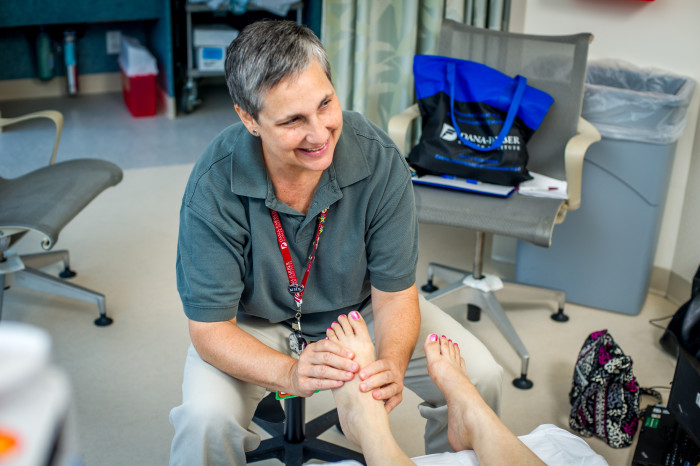
When cancer patients face stress, fatigue, or nausea, they may turn to integrative therapies such as reflexology to help ease symptoms. Although each patient responds individually, reflexology can support relaxation and comfort during cancer treatment and offers an alternative to traditional massage.
What is Reflexology?
Reflexology uses pressure and touch on the feet, hands, and ears to stimulate nerve pathways and encourage relaxation throughout the body. It is an ancient practice that has developed over thousands of years, according to practitioners Bambi Mathay, LMT, and Theresa Ochenkoski, LMT, who work with Dana-Farber’s Leonard P. Zakim Center for Integrative Therapies.
Foot reflexology is not the same as foot massage, Mathay explains. Unlike massage, reflexology does not encourage relaxation through muscle and tissue manipulation. Instead, practitioners touch specific zones in the feet that correspond to reflex points in other areas of the body. Touching the feet stimulates nerve pathways that facilitate relaxation elsewhere.
“You can get a full-body benefit just from the feet,” says Mathay.
Learn more:
When Should a Patient Choose Reflexology?
“Some people don’t resonate with full body touch, and choose reflexology instead,” says Ochenkoski. “It’s a matter of preference.”
Reflexology may be a good choice for patients who don’t want to be touched, or who can’t be touched or moved during treatment. Unlike massage, it involves only the feet, with no repositioning or undressing required.
Reflexology may benefit patients who feel stressed, anxious, nauseous, or who have trouble sleeping. If patients feel more relaxed on reflexology treatment days, they may sleep better that night and have more energy the following day, Ochenkoski says.
“It just snowballs into wonderful things,” adds Mathay. “When reflexology helps with relaxation or helps with one symptom, it seems to also help improve the other symptoms.”
Improving Quality of Life
Carlie Gonzalez, a 15-year-old patient from Milford, Massachusetts, started reflexology last year. She often has it done during her treatments on Tuesdays.
“It takes the stress away in seconds,” Gonzalez points out. “Tuesdays are my favorite days at the clinic.” Gonzalez also says reflexology reduces the nausea she sometimes experiences.
Reflexology can be a reprieve from the stresses of cancer diagnoses, treatments, and everyday life. “Ultimately, our goal with reflexology is to improve quality of life for Dana-Farber patients,” says Ochenkoski.
